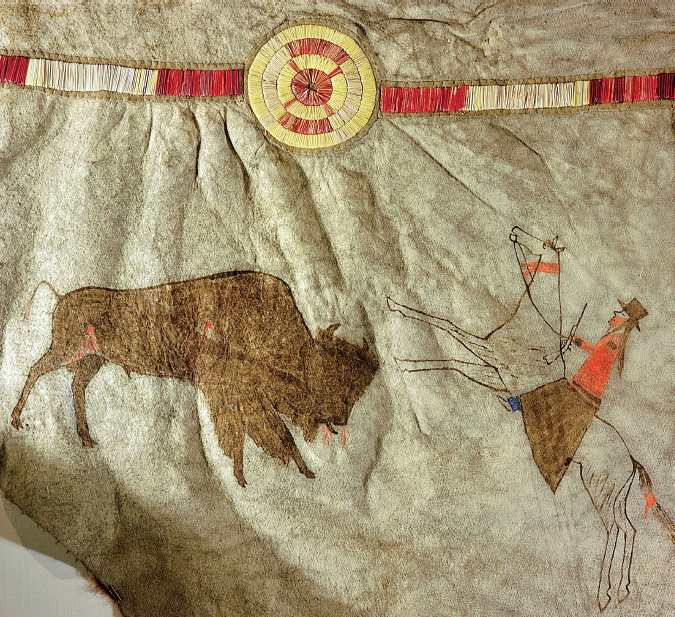Exploring American Histories: Printed Page 465
Exploring American Histories, Value Edition: Printed Page 382
Changing Federal Policy toward Indians

The U.S. government started out by treating western Indians as autonomous nations, thereby recognizing their stewardship over the land they occupied. In 1851 the Treaty of Fort Laramie confined tribes on the northern plains to designated areas in an attempt to keep white settlers from encroaching on their land. A treaty two years later applied these terms to tribes on the southern plains. Indians kept their part of the agreement, but white miners racing to strike it rich did not. They roamed through Indian hunting grounds in search of ore and faced little government enforcement of the existing treaties. In fact, the U.S. military made matters considerably worse. On November 29, 1864, a peaceful band of 700 Cheyennes and Arapahos under the leadership of Chief Black Kettle gathered at Sand Creek, Colorado, supposedly under guarantees of U.S. protection. Instead, Colonel John M. Chivington and his troops launched an attack, despite a white flag of surrender hoisted by the Indians, and brutally scalped and killed some 270 Indians, mainly women and children. A congressional investigation later determined that the victims “were mutilated in the most horrible manner.” Although there was considerable public outcry over the incident, as evidenced by the congressional investigation, the government did nothing to increase enforcement of its treaty obligations. In almost all disputes between white settlers and Indians, the government sided with the whites, regardless of the Indians’ legal rights.
The duplicity of the U.S. government was not without consequences. The Sand Creek massacre unleashed Indian wars throughout the central plains, where the Lakota Sioux led the resistance from 1865 to 1868. In 1866 they killed eighty soldiers under the command of Captain William J. Fetterman in Wyoming. After two years of fierce fighting, both sides signed a second Treaty of Fort Laramie, which gave northern tribes control over the “Great Reservation” set aside in parts of present-day Montana, Wyoming, North Dakota, and South Dakota. Another treaty placed the southern tribes in a reservation carved out of western Oklahoma.
One of the tribes that wound up in Oklahoma was the Nez Percé. Originally settled in the corner where Washington, Oregon, and Idaho meet, the tribe was forced to sign a treaty ceding most of its land to the United States and to relocate onto a reservation. In 1877 Chief Joseph led the Nez Percé out of the Pacific Northwest, directing his people in an excruciating but daring march of 1,400 miles over mountains into Montana and Wyoming as federal troops pursued them. Intending to flee to Canada, the Nez Percé were finally intercepted in the mountains of northern Montana, just thirty miles from the border. Exhausted by the incredible journey, they surrendered. Subsequently, the government relocated these northwestern Indians to the southwestern territory of Oklahoma. In 1879 Chief Joseph pleaded with lawmakers in Congress to return his people to their home and urged the U.S. government to live up to the original intent of the treaties. His words carried some weight, and the Nez Percé returned under armed escort to a reservation in Washington.
The treaties did not produce a lasting peace. Though most of the tribes relocated onto reservations, some refused. The Apache chief Victorio explained why he would not resettle his people on a reservation. “We prefer to die in our own land under the tall cool pines,” he declared. “We will leave our bones with those of our people. It is better to die fighting than to starve.” General William Tecumseh Sherman, commander of the military forces against the Indians, issued orders to “push his measures for the utter destruction and subjugation of all who are outside the reservations in a hostile attitude.” He went on to propose that the army “shall prosecute the war with vindictive earnestness against all hostile Indians till they are obliterated or beg for mercy.” In November 1868, Lieutenant Colonel George Armstrong Custer took Sherman at his word and assaulted a Cheyenne village, killing more than one hundred Indians. Nearly a decade later, in 1876, the Indians, this time Lakota Sioux, exacted revenge by killing Custer and his troops at the Battle of the Little Big Horn in Montana. Yet this proved to be the final victory for the Lakota nation, as the army mounted an extensive and fierce offensive against them that shattered their resistance.
Among the troops that battled the Indians were African Americans. Known as “buffalo soldiers,” a name given to them by the Indians but whose origin is unclear, they represented a cross section of the postwar black population looking for new opportunities that were now available after their emancipation. One enlisted man recalled: “I got tired of looking mules in the face from sunrise to sunset. Thought there must be a better livin’ in this world.” Some blacks enlisted to learn how to read and write; others sought to avoid unpleasant situations back home. Cooks, waiters, painters, bakers, teamsters, and farmers signed up for a five-year stint in the army at $13 a month. A few gained more glory than money. In May 1880, Sergeant George Jordan of the Ninth Cavalry led troops under his command to fend off Apache raids in Tularosa, New Mexico, for which he was awarded the Congressional Medal of Honor.